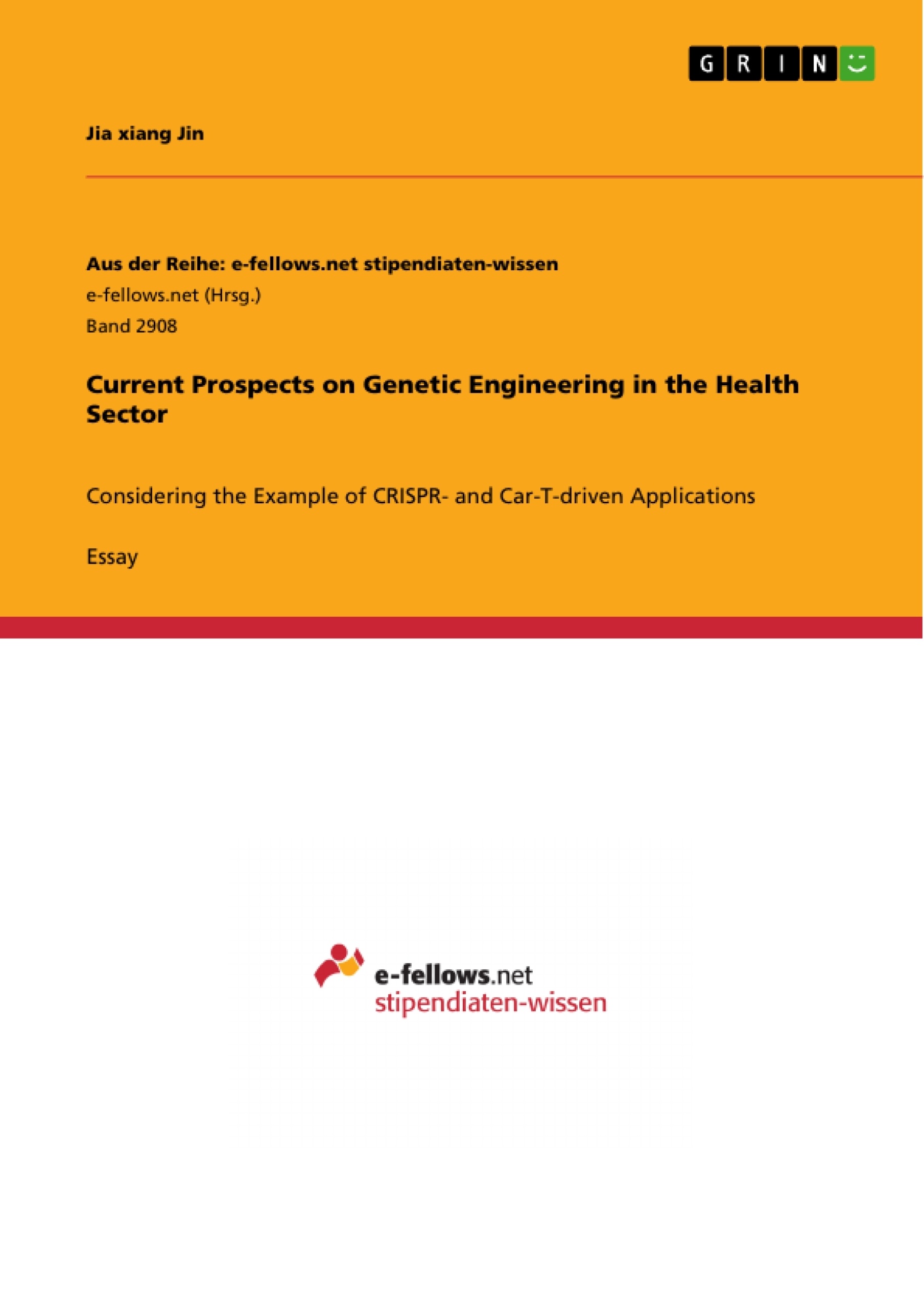With the advance of genetic engineering (GE) new risks and opportunities have come under scientific focus, heralding in the prospect of treating many illnesses such as cancer and germ-line diseases both efficiently and effectively. Clustered Regularly Interspaced Short Palindromic Repeats (CRISPR) assisted approaches embody a new and improved method to perform GE in a very accurate and inexpensive manner when compared to other established methods. Proposed treatments include targeting specific mutated cell lines using Chimeric Antigen Receptor T-Lymphocytes (Car-T) as well as direct editing of the genome to eliminate harmfully mutated gene sequences. Furthermore, the application of CRISPR in the creation of self-propagating genes via Gene Drive (GD) may become an effective and possibly even necessary method to control the dissemination and prevalence of insect-borne diseases.
This essay aims to review foundational arguments in order to facilitate an educated judgement of the current trends in GE. As the field of GE encompasses many different approaches to handle multi-faceted problems and reach diverging goals, it is necessary to define the frameworks of my review. As such, I will put my main focus on presenting the circumstances surrounding applications associated with upholding or improving health standards across national borders. To do so, I will put forth the advantages and possible applications of prominent GE approaches while highlighting a few potential, associated risks that have already been demonstrated empirically.
Inhaltsverzeichnis (Table of Contents)
- Genetic Engineering in the Health Sector
- Advantages and Possible Applications of Prominent GE Approaches
- The CRISPR/Cas9 System
- Car-T as a Treatment for Specific Types of Cancer
- Editing Mutated Sites in an Individual's Genome via the CRISPR/Cas9 System
- CRISPR-assisted Gene Drive
- Empirical Validity of the Thesis
- Car-T Treatments
- Clinical Trials of Car-T Treatment
- A Prominent Case of Car-T Treatment Success
- Disadvantages and Associated Side-Effects of Car-T
Zielsetzung und Themenschwerpunkte (Objectives and Key Themes)
This essay aims to review foundational arguments in order to facilitate an educated judgement of the current trends in genetic engineering (GE). The main focus is on presenting the circumstances surrounding applications associated with upholding or improving health standards across national borders.
- The advantages and possible applications of prominent GE approaches
- Potential risks associated with GE
- The importance of strict and educated supervision in GE
- The ethical considerations of GE and its applications
- The potential of GE to improve health outcomes and address global health challenges
Zusammenfassung der Kapitel (Chapter Summaries)
- Genetic Engineering in the Health Sector: This chapter introduces the topic of genetic engineering and its potential applications in the health sector. It discusses the advancement of genetic engineering, its potential for treating illnesses such as cancer and germ-line diseases, and the need for an educated judgment of its current trends.
- Advantages and Possible Applications of Prominent GE Approaches: This chapter explores the advantages and possible applications of prominent genetic engineering approaches, including CRISPR-assisted gene editing, gene drive, and Car-T therapy.
- The CRISPR/Cas9 System: This chapter delves into the CRISPR/Cas9 system, discussing its potential for treating cancer, editing mutated sites in an individual's genome, and controlling insect-borne diseases.
- Car-T as a Treatment for Specific Types of Cancer: This chapter examines Car-T therapy, a new approach to treating cancer that uses the patient's own immune system to fight the disease. It discusses the mechanisms of Car-T therapy, its effectiveness in treating various types of cancer, and the potential risks associated with it.
- Editing Mutated Sites in an Individual's Genome via the CRISPR/Cas9 System: This chapter explores the use of the CRISPR/Cas9 system to edit mutated sites in an individual's genome. It discusses the potential for a complete cure of hereditary diseases and the ethical considerations surrounding this application.
- CRISPR-assisted Gene Drive: This chapter investigates the use of CRISPR-assisted gene drive to control insect-borne diseases. It discusses the potential to reduce mosquito populations and the importance of strict supervision and control.
- Empirical Validity of the Thesis: This chapter provides empirical evidence to support the thesis of the essay, focusing on the CRISPR/Cas9 system and its applications in treating cancer, editing mutated sites, and controlling insect-borne diseases.
- Car-T Treatments: This chapter further elaborates on Car-T treatments, discussing the mechanisms of action, effectiveness, and potential risks. It highlights the potential of Car-T therapy to save lives and the ongoing research to improve its safety and efficacy.
- Clinical Trials of Car-T Treatment: This chapter presents the findings of clinical trials involving Car-T treatments, highlighting its effectiveness in treating B-cell malignancies and the potential for neurological toxicity. It discusses research efforts to improve the control and safety of Car-T therapy.
- A Prominent Case of Car-T Treatment Success: This chapter examines a prominent case of Car-T treatment success in treating relapsing Childhood Acute Lymphoblastic Leukaemia (ALL). It highlights the effectiveness of the treatment and the associated side-effects, specifically cytokine-release syndrome (CRS).
- Disadvantages and Associated Side-Effects of Car-T: This chapter discusses the disadvantages and associated side-effects of Car-T therapy. It acknowledges the risks associated with the treatment but emphasizes the ongoing research to mitigate these risks and improve the safety and efficacy of Car-T.
Schlüsselwörter (Keywords)
Genetic engineering, CRISPR/Cas9 system, Car-T therapy, gene drive, cancer treatment, hereditary diseases, insect-borne diseases, ethical considerations, health standards, global health, supervision, control, risks, benefits, clinical trials, cytokine-release syndrome.
- Quote paper
- Jia xiang Jin (Author), 2018, Current Prospects on Genetic Engineering in the Health Sector, Munich, GRIN Verlag, https://www.grin.com/document/448486



